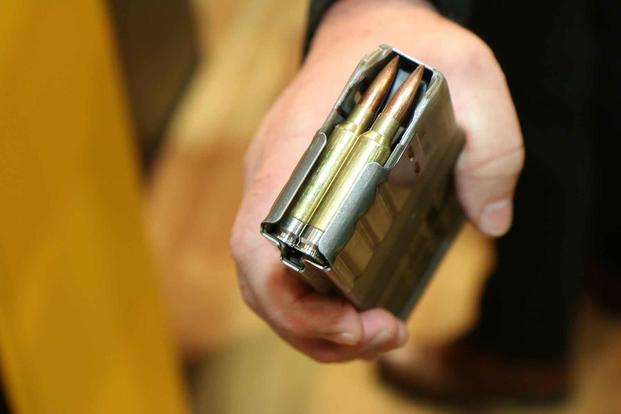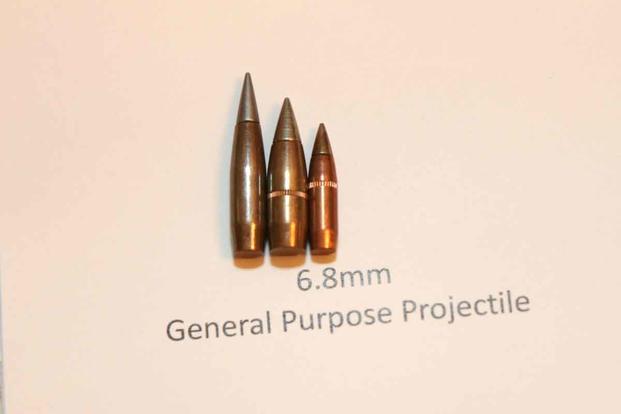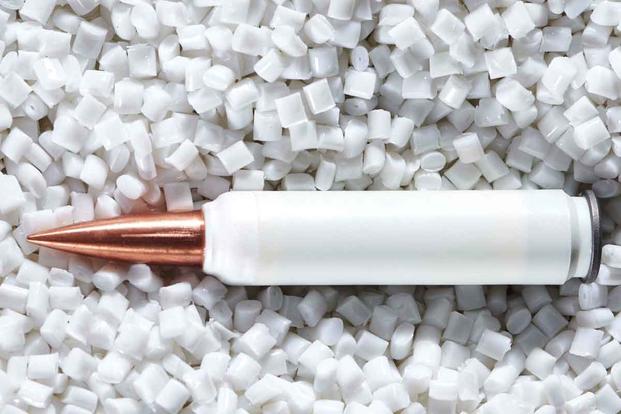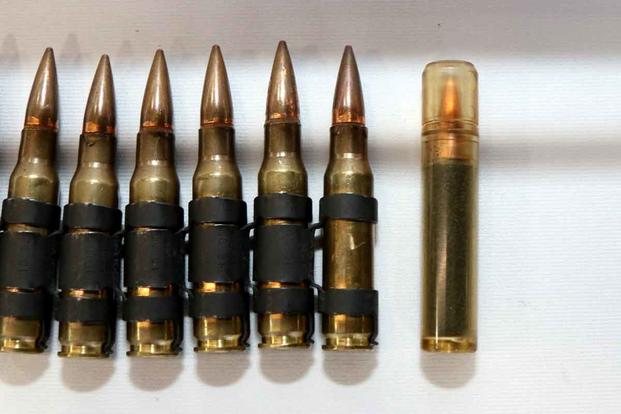As Army weapons officials near the end of a bold effort to arm close-combat units with Next Generation Squad Weapons, new details have emerged about the program's elusive 6.8mm ammo, designed to pierce enemy body armor.
The Army’s long-standing effort to develop this revolutionary round, capable of taking on a sophisticated peer enemy on the battlefield, has required gunmakers to challenge design assumptions and innovate. Now that plans to develop and field the bullet are taking shape, it remains to be seen whether it will live up to its promise to transform the fight for infantrymen.
Just recently, the three gunmakers selected for the final phase of the effort have presented a much clearer picture of the three distinctly different cartridge designs. Both Army and industry officials have disclosed concrete information on the composition of the 6.8mm projectile and how gunmakers have designed their NGSW auto rifle and rifle candidates to cope with potential problems created by the new high-velocity ammunition.
The New General-Purpose Projectile
Since the program took off two years ago, Army officials have refused to discuss specific details about the new 6.8mm bullet and the performance it's capable of producing.
"We want to make sure we are not divulging things at some point that would give our adversaries some ideas of the things that we are trying to do," Brig. Gen. Anthony Potts, the commander of Program Executive Office Soldier, said recently.
The stance is quite different from the openness the Army showed when it unveiled its M855A1 5.56mm Enhanced Performance Round in 2011 and, later, the M80A1 7.62mm EPR. Two Army officials with knowledge of the new 6.8mm General Purpose Projectile confirms to Military.com that it is very similar to the composition of the M855A1 and M80A1, consisting of an exposed steel penetrator that sits on top of a copper slug and is partially encased in a copper jacket.
But so far, neither Army officials or the gunmakers involved in the effort will talk about the muzzle velocity of the 6.8mm round, or the extended range it’s designed to achieve to be lethal against a modern, peer adversary.

The choice for 6.8mm emerged out of a 2017 research initiative: the Small Arms Ammunition Configuration Study. That report convinced Army leaders that infantrymen need a round that would penetrate enemy body armor much more effectively than the current M855A1 EPR round.
"It was the precursor of the Next Generation Squad Weapon program," said Brig. Gen. David Hodne, director of the Soldier Lethality Cross Functional Team and chief of infantry at the Army's Maneuver Center of Excellence at Fort Benning, Georgia. To date, the unclassified version of the study has not been released to the public.
Program officials have said that the NGSW effort is different from past Army small arms programs because it began with the ammunition, and not the design of the weapons.
"If you want to build a new innovative weapon, you start with the ammunition; you don't start with the weapon and try to back into the ammunition -- that is not the most effective means to do it," Potts said. "In the end ... there is no secret, it's all about energy on target. So, we have to understand the targets that we are going after, we have to understand how much energy it takes to defeat that target at that distance, and we have to build a system that delivers that."
From the start, this ambitious performance goal created concerns in the firearms community — particularly penetrating body armor would require much higher velocities than the M855A1 EPR's 2,970 feet per second. Higher velocities often come with higher chamber pressures, which can cause premature parts wear and reliability problems over time.
"If you have a terminal performance objective that includes body armor, there is no doubt you are going to have to raise the pressure to increase velocity because that is a key factor ... in overcoming the body armor," said Trevor Shaw, a retired Army lieutenant colonel who has worked in the firearms industry for more than 15 years. "The more velocity you've got, the better armor penetration you are going to have."
Design Challenges
The three gunmakers selected by the Army for the final phase of the NGSW effort are approaching the problem in different ways.
General Dynamics Ordnance and Tactical Systems Inc. teamed up with True Velocity to produce a composite-cased 6.8mm cartridge. For gun-making expertise, GD joined with Beretta USA, which made the U.S. Army's M9 pistol for decades before the Sig Sauer Modular Handgun System was chosen in 2017 to replace it.
The team was fully aware of the dangers of higher pressures when it designed its automatic rifle and rifle prototypes, said Dave Stouffer, director of business development for the GD-OTS team.
"Higher pressures in the weapon drive all sorts of unsavory things -- barrel wear … the stresses that go back on the bolt face, extraction [problems], premature part wear -- there's all sorts of unfavorable things higher pressure drives," he said.
The GD team chose a bullpup design -- which puts the magazine and bolt-carrier group behind the pistol grip and trigger group -- to avoid the problem and still meet the Army's requirements, Stouffer said.
"One of the benefits of a bullpup-style weapon is that you can run much lower pressures and still achieve the desired velocities because you have a longer barrel," Stouffer said.
GD's rifle variant features a 20-inch barrel, while the AR version has a 22-inch barrel, said Kevin Sims, senior director of business development at GD-OTS, adding that the rifle variant is shorter than the M4A1 and the AR is shorter than the M249. Fully extended, the 33-inch M4A1 has a 14.5-inch barrel, and the M249's 36-inch para version has a barrel length of just over 16 inches.
Without speaking to specifics, Stouffer said, "one of the advantages of this style of weapon is that you can have a much longer barrel in a weapon that is generally shorter."
"If our magazine was in front of the trigger group, this weapon would be 12 to 13 inches longer than it is right now," Stouffer said. "So, you can have the lightest-weight, shortest, most compact weapon that gives you greater capability than you would out of a traditional setup."
True Velocity's lightweight cartridge is a little shorter than the 7.62x51mm round but slightly fatter, so it will require redesigned magazines, Sims said.

Textron Systems teamed up with Heckler & Koch, the maker of the Marine Corps' M27 infantry automatic rifle, and Olin Winchester for its small-caliber ammunition production capabilities.
Textron's case-telescoped 6.8mm cartridge emerged out of the U.S. Army's Lightweight Small Arms Technology program. The technology uses a plastic case rather than a brass case to hold the propellant and the projectile, resulting in a 30% weight savings, Wayne Prender, senior vice president for Applied Technologies & Advanced Programs at Textron, told reporters at AUSA.
The operating system in Textron's prototypes was designed to prevent heat buildup in the system, Prender said.
"Heat and plastic generally don't like each other; we don't have a problem because of the design elements that have been put into the system," he said. "We have a ... rising chamber that allows us to take care of any potential latent heat that may exist in the barrel.
"We do not have any sort of heat problems. The systems have gone through extensive testing."
The CT cartridge is also slightly shorter than the 7.62x51mm round, but because of its cylindrical shape, it will require specially designed magazines for rifle variant.
Sig Sauer developed its 6.8mm cartridge, which is a more traditional design that features a stainless-steel base joined to the brass case to save weight, Paul Snyder, product manager for belt-fed systems at Sig Sauer.
"Since you are making them both independently, you can thin them -- that gives you the weight savings that you need, and it also gives you the increased powder charge that you need to go that velocity that you need," Snyder said. "I can save anybody 20% in weight, case for case; we have patented this technology."
Sig added steel inserts at certain places inside its M4-style design for the rifle prototype to deal with the higher pressure of the 6.8mm round, he said.
"Everywhere there is a wear point, we have reinforced that wear point with stainless steel -- chamber, feed ramp," said Snyder to deal with that "increased velocity of the bolt carrier group."
"These things are going a lot faster. It's a lot more violent. Everything increases when you have a higher chamber pressure round."
Snyder also said Sig included "barrel advancements" to prevent premature wear caused by the 6.8mm round.
"It's an abusive explosion right at the chamber, so barrel wear was a challenge for all competitors, not just Sig," he said.
Sig's cartridge is the same length as 7.62x51mm and can be used in many existing styles of magazines, Snyder said, stressing that the cartridge -- because it's a traditional design -- will not require special machines to produce.
"We can sell the case to anybody and they can load it conventionally, so Lake City [Army Ammunition Plant] does not have to come up with any other tooling to load that cartridge; that is huge," Snyder said.
An Ammo Producer is Chosen
The 6.8mm ammunition for the NGSW will be produced at the Lake City, Missouri, plant. Aside from being on Textron's NGSW team, Olin Winchester recently won a $28 million Army contract to manage the plant for the next decade, according to a Sept. 27 contract announcement.
Military.com reached out to the Army and Olin Corporation to discuss the issue but did not receive a response by press time.
Orbital ATK currently manages Lake City until Olin Winchester takes over Oct. 1, 2020. Under these agreements, the Army pays for upgrades to the facility, but the managing firm invests money as well, according to Whitney Watson, spokesman for Orbital ATK.
"As part of the contract, when a bidder comes in, they will say we will invest X number of dollars into the facility as well, so there is government money that goes in and there is the operator money that also is contributed," said Watson, who added that his firm had invested "a sizeable amount of money" over the past 18 years.
The agreement has allowed Orbital ATK to keep 2,000 people employed while it produces small arms ammo for the U.S. military as well as a sizable amount for the civilian market, Watson said.

The U.S. military puts in its yearly ammunition orders and awards a contract to the managing firm, which buys the cases, powder and bullets from suppliers to produce the ammo to meet strict government guidelines, Watson said.
The Army announced earlier this year that the service has selected a firm to oversee the architecture and design of the new Lake City facility that will produce the 6.8mm ammunition for the NGSW, Watson said, adding that the Army Corps of Engineers will manage the project.
"Shovels haven't even turned dirt yet," he said. "It will be the first new building since the Vietnam era, so Winchester, working with the Corps of Engineers, will be able to determine what that building looks like and the technology that will be required to produce what the government wants."
Currently, Lake City only has the capability to produce traditional, brass-cased ammunition, said Watson, who added that "as far as what we have been told" the Army has not decided what type of new equipment it will need to produce the 6.8mm ammunition.
Army officials said in July that the service won't select the winning firm's weapons and cartridge design until sometime in the first quarter of 2022.
"The ammunition for the Next Generation Squad Weapon will be produced at Lake City, we know that for sure," he said. "And since Winchester has won contract to operate Lake City, we know Winchester will be producing the ammunition for the 6.8mm.
"The picture will become much clearer once the Army has selected, for sure, the design of the Next Gen Squad Weapon. Once they have picked a design, then the dust will settle, and they will determine what that round is going to look like."
-- Matthew Cox can be reached at matthew.cox@military.com.
Read More: No Grunts Under 26, $250K Bonuses: DoD's Most Radical Ideas to Transform the Infantry












